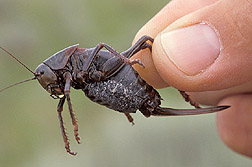This page has been archived and is being provided for reference purposes only. The page is no longer being updated, and therefore, links on the page may be invalid.
Tiny Transmitters Gauge Cricket MovementsBy Erin Kendrick-PeabodySeptember 26, 2003 Mormon crickets were on the move again this summer. In bands up to three miles deep and one mile across, they marched across several western states, devastating croplands and bewildering residents as they blanketed roadways and the sides of buildings. But this time something else was moving with them. A team of researchers, led by Agricultural Research Service scientist Gregory Sword, was tracking the insects. For the first time, researchers aimed to find out how far the flightless Mormon cricket—that looks more like a grasshopper—could move in a day. Their surprising discovery? One cricket walked more than one-and-a-quarter miles across steep hills and valleys. Researchers are investigating Mormon crickets' travels in hopes of one day predicting their movements. At outbreak levels, the two-inch-long insects walk in bands of millions of individuals, consuming most plants in their path, including crops, grasses and ornamentals. Up to now, researchers estimated the insect could move about a mile a day. In July, to determine the pest's true mobility, Sword, Pat Lorch from the University of North Carolina and Darryl Gwynne from the University of Toronto charted the migration habits of 12 Mormon crickets in northwestern Colorado. Sword is an ecologist at the ARS Northern Plains Agricultural Research Laboratory in Sidney, Mont. Micro-radio transmitters, about one-quarter of the insect's weight, were glued to individual crickets. These transmitters provided signals so that the team could find the same insects 24 hours later. The ultimate goal, says Sword, is to develop a model that predicts where migrating cricket bands will move next. Knowledge of a band's future change in direction, for instance, would allow land managers to pinpoint pesticide applications, reducing exposure of nontarget species. Generally, Mormon crickets play an important role in western environments by providing food for wildlife and contributing to nutrient cycling on rangelands. ARS is the U.S. Department of Agriculture's chief scientific research agency. |

